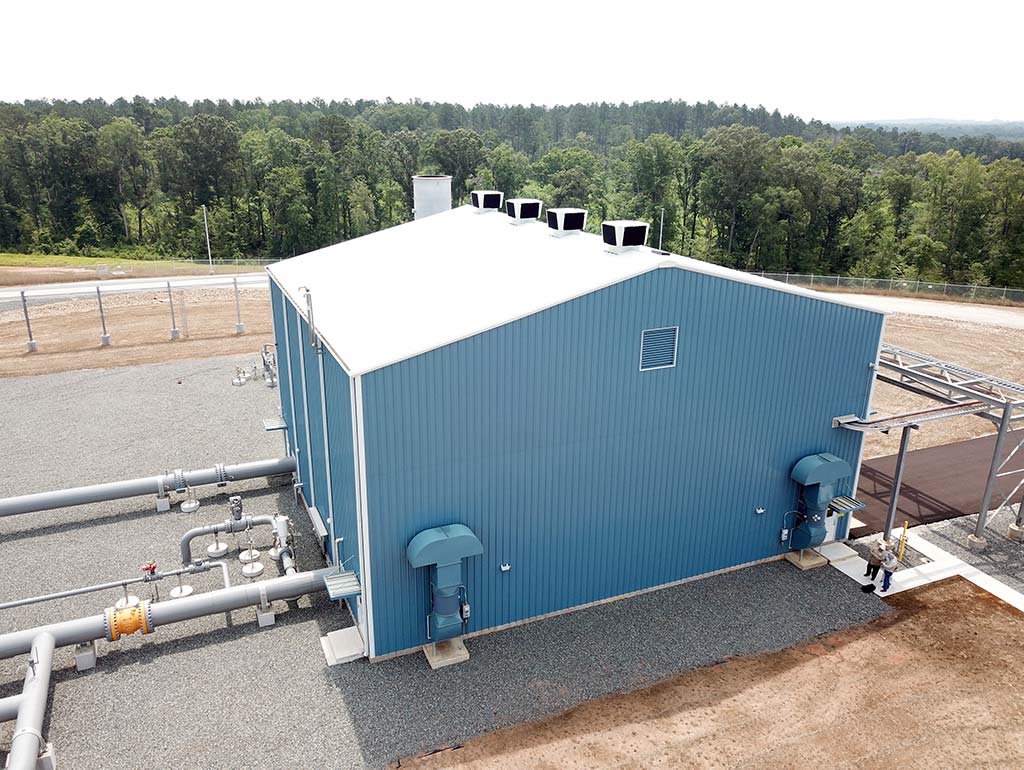Ventilating gas pipeline compressor buildings involves more than simply installing a few fans. Based on our expertise, we’ve found that each facility presents its own distinct challenges, making it impossible to apply a standardized ventilation solution across all pipeline compressor stations. In this blog, I’ll discuss the criteria for pipeline compressor building ventilation system design.
AIR CHANGE RATE
 Every enclosed compressor building requires a specific air change rate. When natural gas pipelines connect to compressors, gas leakage into the surrounding air is possible. Excessive gas accumulation poses dual risks: it can compromise worker safety and create conditions where a simple electrical spark could trigger a fire or explosion.
Every enclosed compressor building requires a specific air change rate. When natural gas pipelines connect to compressors, gas leakage into the surrounding air is possible. Excessive gas accumulation poses dual risks: it can compromise worker safety and create conditions where a simple electrical spark could trigger a fire or explosion.
The National Electric Code (NEC) by the National Fire Protection Association (NFPA) establishes various hazardous area classification standards for electrical systems. For instance, Class I, Division 1 facilities must incorporate explosion-proof equipment. By enhancing air exchange rates, facilities might qualify for reclassification from Division 1 to Division 2, potentially eliminating the need for some expensive explosion-proof installations.
The American Petroleum Institute (API)’s Recommended Practice 500 outlines the required air changes to maintain appropriate building classifications. Section 6.3.2.4.2 states:
“Enclosed areas (rooms, buildings, or spaces) that are provided at least 0.028 cubic meters (1.0 cubic foot) of air volume flow per minute per square foot of floor area, but at least six (6) air changes per hour, can be considered as adequately ventilated.”
Heat output, measured in BTU/hr, is another crucial consideration. Equipment generating substantial heat may necessitate additional air changes to meet classification requirements. If not factored into the ventilation system design, excessive building heat can also lead to equipment malfunction.
ACOUSTIC REQUIREMENTS
While no formal acoustic regulations exist for compressor stations, sound management often becomes necessary for worker comfort and maintaining positive community relations.
In remote locations, compressors and auxiliary equipment might operate without building enclosure. Since noise pollution isn’t a concern in such isolated areas, sound reduction measures become unnecessary.
However, the scenario changes dramatically for compressor stations near residential areas. These facilities require acoustic designed materials for walls and roofs. When ventilation equipment installation necessitates a wall or roof penetration, sound dampeners must be incorporated to contain noise within the facility.
BUILDING SIZE
Building dimensions significantly influence various aspects of the ventilation system design. For instance, a compact compressor facility may only need basic ventilation equipment like a supply or exhaust fan paired with a louver. In contrast, larger facilities typically require a more comprehensive setup incorporating both supply and exhaust fans. As building size increases, more powerful fans become necessary to maintain adequate air circulation rates.
COMPRESSOR DRIVE
Compressors can operate using three primary power sources: reciprocating engines, gas turbines, or electric motors, each with distinct advantages and limitations. For electrically driven systems, we strongly advise implementing a dedicated motor cooling system. This specialized setup circulates and cools ambient air through the motor, preventing electrical component overheating.
ELDRIDGE EXPERTISE
Taken individually, none of these criteria present a great challenge in ventilation system design. What makes a pipeline compressor-building ventilation system design project unique is that all criteria must be considered simultaneously to achieve air flow and acoustic requirements.
Eldridge has designed hundreds of pipeline compressor-building ventilation systems that have successfully achieved air flow and acoustic requirements. Let us put our experience to work to make your next pipeline compressor-building ventilation system design project a success.
